Roasted Bison Tenderloin with Merlot Sauce and Faro Risotto

Roasted Bison Tenderloin with Merlot Sauce
Lean and one of the healthiest red proteins afield, the richly flavoured bison is nicely balanced for all palates with a good Merlot.
1/4 cup (60 mL) good quality red wine vinegar
2 shallots, sliced
1 clove garlic, sliced
2 sprigs fresh thyme
1 cup (250 mL) good quality Merlot
4 cups (1 L) vegetable stock
1 1/4 pounds (575 g) bison tenderloin, centre cut
3 Tbsp (45 mL) grapeseed oil
Kosher salt
Pepper
Preheat oven to 425 F (220 C).
Place a medium saucepan over moderate heat and add the red wine vinegar, shallots, garlic, and fresh thyme. Bring to a boil and reduce to almost dry and add the Merlot. Reduce again to almost dry and add the veal stock. Reduce by half, skimming any impurities from the top.
Liberally season the entire bison tenderloin with salt and pepper. In a large sauté pan, heat the oil until almost smoking. Brown the bison well on all sides and place in the preheated oven. For medium-rare meat, cook for 10 to 12 minutes and allow the meat to rest for at least 15 minutes. Just before serving, pop the tenderloin back in the oven for 3 minutes. Cut into 8 portions, serve 2 to each person, and finish with the Merlot sauce. Serves 4.
Faro Risotto
Faro is the original ancient grain, and its nutty appeal makes itself immediately obvious; it’s love at first bite and a great change from rice.
3 cups (750 mL) chicken or vegetable stock
2 Tbsp (30 mL) grapeseed oil
1 shallot, minced
1 1/2 cups (350 mL) faro, rinsed
1/2 cup (125 mL) grated Parmesan
Salt to taste
Heat the stock to almost boiling. In a medium saucepan, heat the grapeseed oil over moderate heat. Add the shallots to the oil and sauté briefly. Add the faro and sauté briefly (approximately 2 minutes). Add a large ladle of simmering stock and stir until the stock is absorbed. Continue adding stock until the faro is cooked through, about 15 minutes. Remove from the heat and stir in the Parmesan. Serves 4.
source: "Cru", alive #287, September 2006




